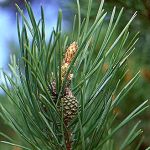| Common Name: |
Scots Pine |
| Botanical Name: |
Pinus sylvestris |
| Genus: |
Pinus |
| Family: |
Pinaceae |
| Native Location: |
Europe (excluding far north) and temperate Asia |
| Cultivation: |
Well-drained, neutral to acid soil in sun. Pinus sylvestris thrives in both acid and alkaline soils. Pinus palustris tolerates drought and poor soil but needs warmth and humidity. Remove dead branches in winter. Restrict the leading shoots. Foliage may be damaged by adelgids, caterpillars of the pine-shoot moth, sawfly larvae, canker, dieback, Botrytis, and rust. Trees may be killed by honey fungus. |
| Propagation: |
By seed sown in spring (species and varieties only); by layering (P. mugo Pumilio Group); by grafting in late winter (cultivars). |
| Harvest: |
Leaves and young shoots are collected during the growing season and usually used fresh for decoctions and syrups (P. sylvestris). Resin is tapped by cutting vertical grooves in the bark and collecting the exudate; oil is distilled or solvent extracted from wood and bark (P. palustris). Oil is distilled from leaves (P. mugo Pumilio Group). Oils are processed into ointments, gels, emulsions, inhalants, and rubbing oils. Tar is distilled from roots (P. sylvestris). |
| Height: |
15-30m (50-100ft) |
| Width: |
6-9m (20-28ft) |
| Variations: |
Aurea Group
syn, Aurea
(Golden Scots Pine)
Is slow growing, with bright yellow foliage in winter
Height: 10-15m (30-50ft) |
Fastigiata
Is narrow and upright with ascending branches.
Height: 8m (25ft)
Width: 1-3m (3-10ft) |
|
| Hardiness: |
Z2-8 |
| Parts Used: |
Leaves, young shoots and buds, tar, oil. |
| Properties: |
A bitter, aromatic, warming herb that acts as a diuretic and expectorant, improves blood flow locally, and has a tonic effect of the nerves. It is strongly antiseptic. |
| Medicinal Uses: |
Internally for urinary and respiratory tract infections, and gall bladder complaints. Externally for arthritis, rheumatism, sciatica, poor circulation, bronchitis, mucus, sinusitis, asthma, pneumonia, neuralgia, acne, fatigue, and nervous exhaustion. Oil is used in aromatherapy for similar complaints. |
| Economic Uses: |
Oil and tar are added to disinfectants, bath preparations, detergents, and preparations to stimulate hair growth. |
| Warning: |
Contraindicated in allergic skin conditions. |
| Bibliography: |
Encyclopedia of Herbs by Deni Brown Copyright © 1995, 2001 Dorling Kindersley Limited. pp 318-319 |

